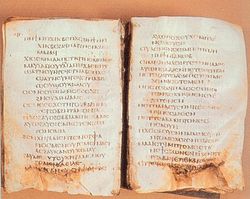Coptic script
| Coptic script | ||
|---|---|---|
| Font | alphabet | |
| languages | Coptic language : Sahidic , Bohairisch , Fayyumisch , Achmimisch , Subachmimisch | |
| Usage time | from 2nd century AD, superseded by Arabic from the 7th century. Still used today for sacred purposes in the Coptic Church. | |
| Used in | Egypt, Nubia | |
| Officially in | Egypt | |
| ancestry |
Protosinaitic script → Phoenician script → Greek alphabet → Coptic script |
|
| Derived | Old Nubian script | |
| particularities | Has 8 letters more than the Greek alphabet | |

Psalter of al-Mudil , 4th / 5th cent. century
|
||
The Coptic script is an alphabet script that has been used for the Coptic language since the 2nd century AD and is derived from the Greek alphabet . The shape of the letters differs partly from the Greek, and the Coptic script has been expanded by 8 characters of demotic origin. These characters were needed to write the sounds [ʃ], [f], [x], [h], [tš], [kʲ] and the sound combination [ti] that cannot be represented with the Greek alphabet. In contrast to the demotic, vowels could also be written for the first time in the written form of Egyptian, which was important for research into the predecessor languages of Egypt. The Coptic alphabet contains a total of 32 letters.
History of writing
Since the conquest of Egypt in 332–331 BC Under Alexander and the subsequent Ptolemaic rule, Egypt was subject to intensive Hellenization . This is how Greek became the language of administration. Knowledge of the Greek language and literature and the Greek alphabet became widespread over time. Since the 1st century AD, some texts in Egypt were written in Middle Egyptian or Demotic in the Greek script, known as the Old Coptic script . It contains demotic additional letters for certain sounds foreign to Greek. The first texts are mainly magical texts like the papyrus BM 10808 .
Since the Christianization of Egypt in the 3rd / 4th In the 19th century, the older Egyptian scripts, i.e. the hieroglyphs , the hieratic and the demotic script, were completely abandoned, and the Christians living in Egypt now wrote Egyptian texts in a modified form of the Greek script, which is now known as the Coptic script.
Since Coptic was superseded by Arabic as a colloquial language , the Coptic script has only been used in the Coptic Church for liturgical purposes. Since knowledge of Coptic is only available in exceptional cases, the liturgical books are bilingual in Coptic and Arabic. In the 14th century, a monk wrote what is probably the last original poem of this language, including its preliminary stages, which has long been used by mankind in the Sahidic dialect.
Since the 8th century AD, the Old Nubian spoken in today's Sudan was written using the Old Nubian script , which was derived from the Coptic script.
The writing system and the letters
In contrast to the systems previously used for the writing of Egyptian, the Coptic script is a phonetic transcription that takes vowels and consonants into account. Depending on the dialect, there are about 30 letters; As a rule, a letter in the Coptic script represents a phoneme , but there are a few exceptions. ⲑ th , ⲫ ph , ⲭ kh , ⲝ ks , ⲯ ps and ϯ ti are monograms in most dialects that each represent a sequence of two phonemes. Conversely, / y / plene can be written as ⲉⲓ and / w / as ⲟⲩ . The phoneme / ʔ / has no corresponding letter. Sometimes the Coptic script is based on the phonons instead of the phonemes, so / nō / [nu] is written as ⲛⲟⲩ ( nu ). In addition, consonants could be marked with a supralinear line if they were syllabic.
The following list gives an overview of the entire Coptic alphabet with the Latin transcription, the corresponding phonemes and the reconstructed pronunciation. Some of the phonemes given differ depending on the dialect; the reconstructed pronunciation only refers to genuinely Coptic words, while the pronunciation of Greek words partly differed. You can find more information about the representation of numbers in the last column in the article Coptic Numbers .
Coptic in Unicode
Unicode encodes the Coptic script in the Unicode block Coptic , Unicode block Greek and Coptic and the special numerals used mainly in Bohairian under the Unicode block Coptic numerals .
literature
- Jan Quaegebeur: De la préhistoire de l'écriture copte. In: Orientalia lovaniensia analecta , 13, 1982, pp. 125-136.
- Rodolphe Kasser : Alphabet in Coptic, Greek , Alphabets, Coptic , Alphabets, Old Coptic . In: Aziz S. Atiya (Ed.): The Coptic Encyclopedia. Macmillan Publishing Company, New York 1991, Volume 8, pp. 30-45.
- Wolfgang Kosack : Textbook of Coptic. Part I: Coptic Grammar. Part II: Coptic Reading Pieces. Academic Printing and Publishing Company, Graz 1974, ISBN 3-201-00889-3 .
- Wolfgang Kosack : Coptic Hand Lexicon of Bohairischen. Coptic - German - Arabic. Verlag Christoph Brunner, Basel 2013, ISBN 978-3-9524018-9-7 .
Web links
Individual evidence
- ^ Siegfried G. Richter : The Coptic Egypt. Treasures in the shadow of the pharaohs. With photos by Jo Bischof. Wissenschaftliche Buchgesellschaft, Darmstadt 2019, ISBN 978-3-8053-5211-6 , pp. 98-102.
- ↑ The Triadon. A Sahidic didactic poem from the 14th century . Translated by Peter Nagel (= Martin Luther University Halle-Wittenberg: Scientific contributions, Series K: Byzantine contributions . Volume 7 ). Science journalism department of the Martin Luther University, Halle (Saale) 1983, DNB 850819342 .

